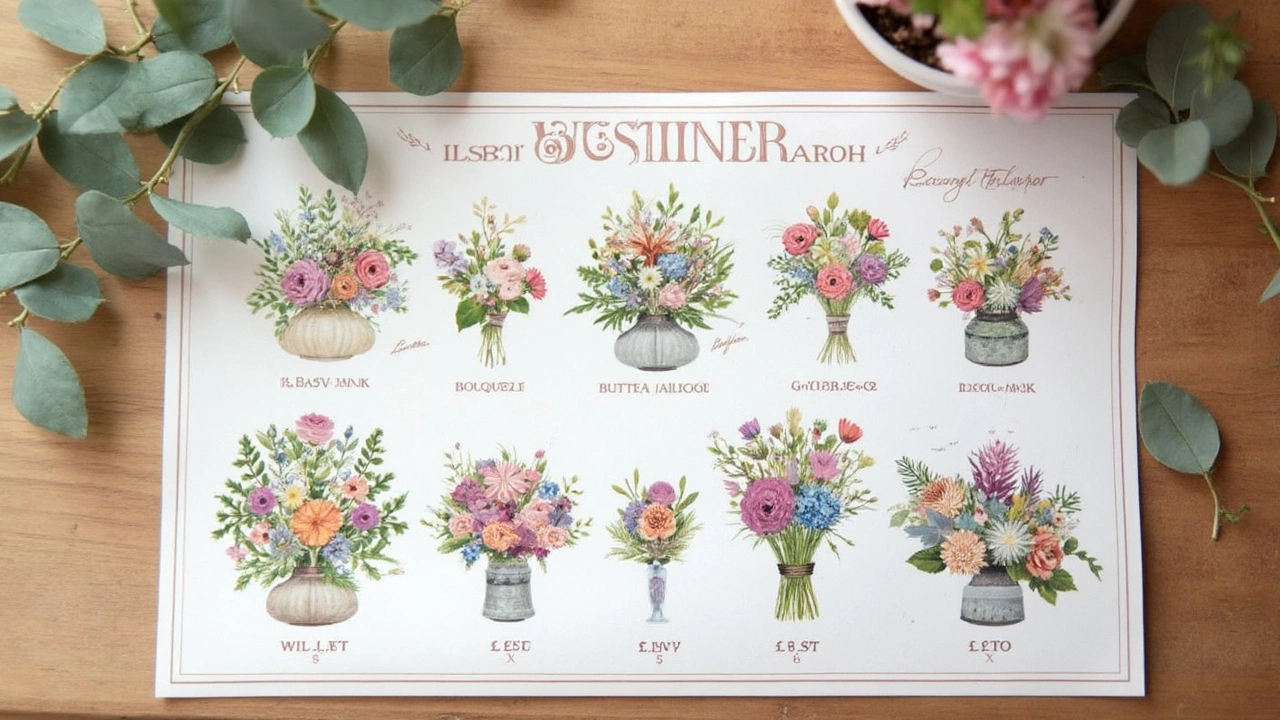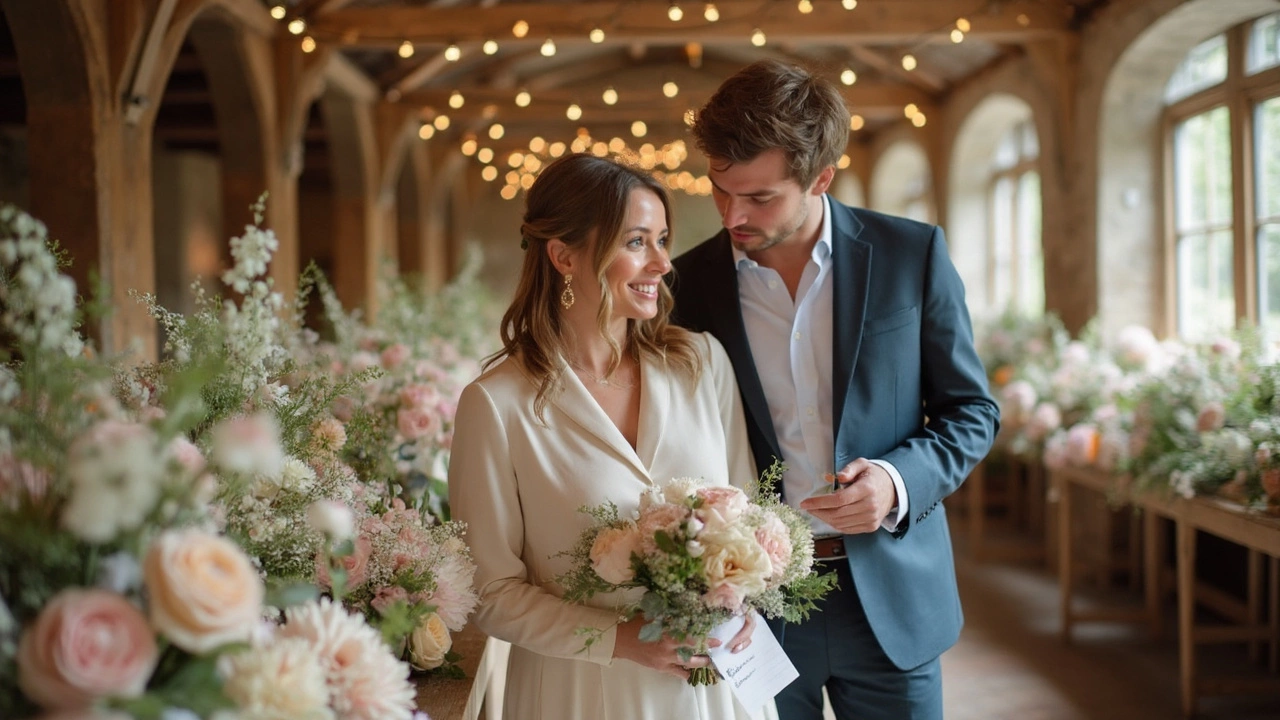Setting your flower budget for a wedding in 2024 can get confusing fast. You see Pinterest-perfect bouquets and archways everywhere, but when you actually get a florist quote, the numbers sometimes feel out of reach. Is it just you? Not at all. Right now, the average couple in the US spends between $2,500 and $6,000 on wedding flowers alone—and if you want those lush installations, the sky’s the limit. Still, you don’t have to break the bank to get beautiful blooms.
So, where does all that money go? It’s not just about the flowers. Labor, setup, delivery, and even striking (that’s florist speak for taking stuff down) add to the total. Plus, since everyone wants peonies and garden roses in peak season, prices for certain flowers keep climbing. Don’t worry—if you know what to expect and where the money goes, you can plan a budget that gets the look you love without surprise charges later.
- Why Wedding Flowers Cost So Much
- 2024 Flower Price Ranges
- Budgeting for Different Floral Styles
- Tips to Save Without Sacrificing Style
- Hidden Costs Brides Forget
- DIY vs. Pro Florist: What's Worth It?
Why Wedding Flowers Cost So Much
The price tag for wedding flowers can feel like a shock, but there are legit reasons why these costs are high in 2024. First, you aren’t just paying for the bundles you see on the tables. Behind every bouquet, there’s a whole process—sourcing, processing, arranging, storing, delivering, setting up, and later packing everything away. That takes time, skill, and real muscle work, especially when you're dealing with delicate blooms and unpredictable weather.
For most weddings, florists order flowers days in advance, sometimes from local growers but often from wholesalers overseas. With transportation fees up (thanks to higher fuel and labor costs), even getting the flowers to your florist isn't cheap. Then, your florist spends hours prepping each stem, removing leaves, and arranging everything so it actually looks good—not tossed on the table like grocery store flowers. The person who touches your bouquet last probably has years of experience—creativity and expertise aren't free.
Also, certain flowers just cost more. Peonies, orchids, and even some greenery have steep prices, especially if they're out of season. If you ask for something that doesn’t grow locally in spring (like dahlias in January), there’s a premium on sourcing and shipping. Plus, 2024's most popular arrangements—oversized arches, ceiling installations, and big bouquets—need hundreds or even thousands of stems, so the total adds up fast.
And here’s something most couples forget: wedding florists charge for labor like delivery, setup, and teardown. A team might set up early in the morning so everything looks perfect and haul everything away at midnight after the party. That’s a long day, and every extra hour adds to your bill.
- wedding budget 2024 factor: Don’t forget that prices shot up in the last few years because of climate change impacts, supply shortages, and way more couples getting married on the same weekends post-pandemic. It’s a squeeze on every vendor, not just the flower shop.
- Florists often rent or buy special vases, candles, and hardware. Those costs are rolled into your quote too. If the venue is strict about cleanup, your florist may charge you extra for late-night pickups or tricky setups.
- The style you want matters. Lush, romantic looks need more flowers and time. Simple, minimalist styles usually cost less, but not always—sometimes rare flowers or unique designs offset the savings.
When you see your floral quote, remember it’s not just flowers you’re paying for; it’s the whole package from start to finish. Knowing all this makes it a lot easier to set a realistic budget and not feel ripped off when the final total pops up.
2024 Flower Price Ranges
If you’re wondering how much to set aside for wedding flowers in 2024, let’s get into the real numbers. Prices have definitely gone up, thanks to fuel costs, weather issues, and higher demand for those “wow” arrangements you see all over Instagram.
Here’s a breakdown of what different pieces might run you this year. Expect these ranges if you’re booking with a full-service florist in a mid-sized city. Tiny elopement bouquets cost less, while big city or luxury weddings with top florists can double these numbers.
| Item | Low End (USD) | High End (USD) |
|---|---|---|
| Bridal Bouquet | $200 | $500 |
| Bridesmaid Bouquet | $85 | $200 |
| Boutonniere | $18 | $40 |
| Corsage | $25 | $55 |
| Ceremony Arch/Chuppah Flowers | $400 | $2,000 |
| Table Centerpieces (each) | $75 | $250 |
| Floral Installations | $800 | $5,000+ |
Keep in mind, labor and delivery are usually separate. Some florists roll these into your package, but others will tack them on at the end, so always double-check. Also, certain flowers like peonies and ranunculus can cost a lot more when they’re out of season. If you’re open to local, in-season blooms, you’ll likely save some cash.
The wedding flowers budget isn’t just about pretty centerpieces—it covers everything from bouquets to boutonnieres to any larger installations at your venue. If you’re tight on cash, mix pricier blooms with budget-friendly ones like mums, carnations, and greenery to keep costs down without sacrificing style.
As you plan, always ask your florist for a detailed quote and talk about what matters most to you. Maybe splash out on your ceremony backdrop and go simpler on table flowers, or the other way around. The right price mix is all about what you want guests to remember most.
Budgeting for Different Floral Styles
Your floral style sets the mood for your whole wedding, but it seriously steers your flower budget, too. Going lush and romantic with cascading centerpieces? Expect a higher bill. Prefer something modern and minimal? You’ll probably spend less, but you’ll still want a plan.
The old rule of thumb says to set aside about 10% of your full wedding budget for flowers, but that only works for mid-range looks. Here’s how things usually break down in 2024:
- Classic and Simple: Think small bouquets, basic centerpieces, and just a touch of flowers at the ceremony. This usually runs between $1,500 and $3,000 for a wedding of 100 guests.
- Mid-Range Romantic: Lush bouquets, table garlands, floral aisle markers, and a few extras for the cake or welcome sign. Expect to pay around $3,500–$6,000.
- Maximalist/Vintage Luxe: Huge archways, flower walls, hanging installs, and full reception flowers. These weddings often hit $8,000–$15,000, sometimes more if you want rare blooms or out-of-season flowers.
Don’t forget about repurposing flowers to save money. For example, those ceremony arrangements can often be moved over to your head table or bar for the reception. Modern florists are used to requests like this and can plan for it if you ask upfront.
If you’re on a tighter budget, ask about using more greenery or choosing flowers that are in season. Carnations, mums, or locally grown seasonal flowers can look just as pretty as pricier options.
Before you sign any floral contract, get a line-item estimate. Ask your florist for a visual mock-up if you can. This way, you’ll see where your dollars are going instead of ending up surprised by the final invoice for your wedding flowers.

Tips to Save Without Sacrificing Style
You don’t have to drop thousands to make your wedding flowers pop. There are real, tried-and-true ways to lower your floral bill and still get a beautiful look. Here’s how people planning for a wedding budget 2024 are doing it right now:
- Stick to seasonal and local blooms. Getting married in June? Peonies will likely be at their cheapest. Don’t insist on dahlias in April—out-of-season flowers mean extra shipping and higher prices.
- Reuse your flowers. That stunning ceremony arch? Move it behind your sweetheart table for the reception. Bridal bouquets can double as head table decor. It’s a quick flip that stretches your dollar.
- Go bigger with greenery. Lush greens (like eucalyptus or ferns) fill space, create drama, and cost a fraction of fancy blooms.
- Choose statement pieces over lots of little arrangements. Spend your money on one or two wow moments—a dramatic entrance or bold centerpieces—and keep the rest simple.
- Rethink your guest count. Fewer tables mean fewer centerpieces. Even cutting just two tables can save you $200-$400.
- Skip extras you don’t need. You really don’t need florals in every nook. Focus on the areas where guests spend the most time.
Here’s a look at typical 2024 pricing for ways to reduce costs:
| Money-Saving Move | Estimated Savings |
|---|---|
| Using flowers in season | $500 - $1,200 |
| Repurposing ceremony flowers | $250 - $800 |
| Choosing more greenery | $400 - $1,000 |
| Cutting guest list by 20 people | $250 - $600 |
Florists are used to working with budgets, so don’t be shy about sharing yours upfront. Ask where it makes the most difference to splurge or save. Most will be honest—sometimes swapping out just one high-end flower for a similar, cheaper variety can save big without guests noticing a thing.
Hidden Costs Brides Forget
When it comes to planning your wedding budget 2024, flower expenses can sneak up on you. It's easy to focus on bouquets and centerpieces, but there are extra charges that couples often miss until it’s time to sign the contract.
For starters, delivery and setup are rarely included in the list price for your arrangements. Most florists charge fees for getting your flowers to the venue and setting everything up, and those fees can run from $150 to $500 or more, depending on your location and the complexity of your order. If you’re tying the knot in a city or at a tricky location, costs can jump because of parking fees, building restrictions, or even elevator access.
Striking—AKA the cleanup—is another area people forget. Many venues require all décor to be removed by midnight. If your florist or their crew needs to come back after your party, expect an extra line item, usually around $100 to $300. Sometimes, this fee is doubled if it’s really late at night.
Flower vessels might seem like a small detail, but the cost adds up. Rental charges for vases, urns, arches, and candleholders often aren't baked into the initial quote. If you want special props, like flower walls or trending floating arrangements, add those to the bill, too. Ask your florist for a full rental breakdown so you’re not surprised by an extra $200 to $600 at the end.
There’s also the price of last-minute changes. If you swap out flowers for more premium blooms just a couple of weeks before the wedding, you’ll usually pay more—and sometimes a rush fee on top of it.
- Tip: Review every line of your florist’s proposal. Ask them to point out what’s included and what’s not.
- Double-check who’s responsible for cleanup to avoid being stuck with an extra bill after the big day.
- If you’re using your ceremony flowers at your reception, confirm there’s staff on hand to move them—otherwise, that service can be another hidden cost.
It’s always better to spot these costs upfront, so you can plan smarter and keep your wedding flower budget on track.
DIY vs. Pro Florist: What's Worth It?
The question comes up every single year: Can you get the look you want doing your own wedding flowers, or is hiring a pro florist the way to go? It really depends on your budget, your vision, and how much chaos you can handle the week of your wedding. Some people love getting hands-on. Others say it wasn’t worth the stress—no matter how much they saved.
If you care most about saving money, wedding flowers are actually one of the things where a DIY approach can slash costs. Bulk flowers from wholesalers or membership stores (think Costco or Sam’s Club) often cost 50–60% less than a professional setup. For example, a typical bridal bouquet from a florist runs $150–$300, while DIYers can whip one up for around $50–$80 in materials.
| Item | DIY Cost | Pro Florist Cost |
|---|---|---|
| Bridal Bouquet | $50–$80 | $150–$300 |
| Bridesmaid Bouquet | $20–$40 | $75–$150 |
| Table Centerpiece | $25–$55 | $75–$250 |
| Arch Arrangement | $90–$180 | $300–$700 |
Sounds great, right? But hold up—DIY isn’t free of headaches. Here’s what takes people by surprise:
- Time crunch: You’ll need 24–48 hours before the wedding to prep, arrange, and store the flowers somewhere cool. You’ll also need a few helping hands.
- Skill level: Arranging flowers that look “Pinterest perfect” is harder than a Youtube video makes it seem—especially big statement pieces.
- Logistics: Getting flowers delivered on time, dealing with last-minute wilting, and transporting arrangements to your venue can be a scramble.
- Cleanup: You (or family/friends) are in charge of setup and takedown—not ideal when you want to hit the dance floor.
Professional florists charge more, but you’re also paying for their experience—and their team, backup supplies, proper storage, and stress management. They’ll deliver arrangements, handle any flower emergencies, and make sure every stem is on point. If you have a complicated vision (like a floral arch or hanging installations), this is not a good place to wing it.
Honestly, a lot of couples mix both: DIY simple stuff like table centerpieces, then hire a pro for key items—bouquet, arch, big statement pieces. That way, you save some cash and keep your sanity.

